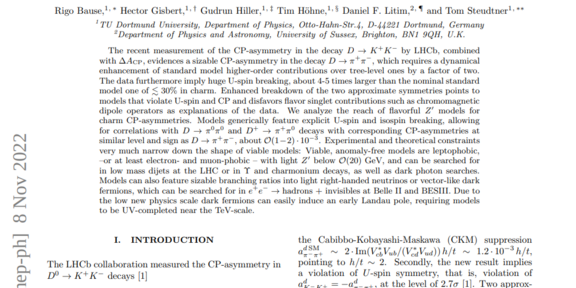Two is better than one: The U-spin-CP anomaly in charm
- Hiller

Abstract:
The recent measurement of the CP-asymmetry in the decay D→K+K− by LHCb, combined with ΔACP, evidences a sizable CP-asymmetry in the decay D→π+π−, which requires a dynamical enhancement of standard model higher-order contributions over tree-level ones by a factor of two. The data furthermore imply huge U-spin breaking, about 4-5 times larger than the nominal standard model one of ≲30% in charm. Enhanced breakdown of the two approximate symmetries points to models that violate U-spin and CP and disfavors flavor singlet contributions such as chromomagnetic dipole operators as explanations of the data. We analyze the reach of flavorful Z′ models for charm CP-asymmetries. Models generically feature explicit U-spin and isospin breaking, allowing for correlations with D→π0π0 and D+→π+π0 decays with corresponding CP-asymmetries at similar level and sign as D→π+π−, about (1−2)⋅10−3. Experimental and theoretical constraints very much narrow down the shape of viable models: Viable, anomaly-free models are leptophobic, -- or at least electron- and muon-phobic -- with light Z′ below (20) GeV, and can be searched for in low mass dijets at the LHC or in Υ and charmonium decays, as well as dark photon searches. Models can also feature sizable branching ratios into light right-handed neutrinos or vector-like dark fermions, which can be searched for in e+e−→hadrons + invisibles at Belle II and BESIII. Due to the low new physics scale dark fermions can easily induce an early Landau pole, requiring models to be UV-completed near the TeV-scale.
Zur Veröffentlichung:
https://arxiv.org/abs/2210.16330
Unsere weiteren Veröffentlichungen finden Sie auf der zugehörigen Publikationsliste.

